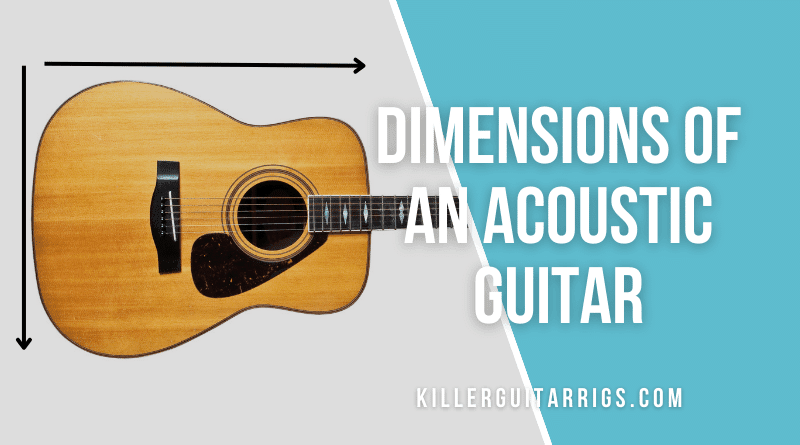While there are dozens of acoustic guitar manufacturers making hundreds of different models, acoustic guitars thankfully tend to conform to relatively standardized sizes, dictated by the body style.
In this KillerGuitarRigs Guide, we’ll take a look at the dimensions of the most common types of acoustic guitars. In addition to the approximate measurements, we’ll also be bringing you some information on how those dimensions affect tone, comfort, and playability.
If you’re curious to learn more about the dimensions of acoustic guitars, you won’t want to miss this!
Contents
What are the Dimensions of a Dreadnought?
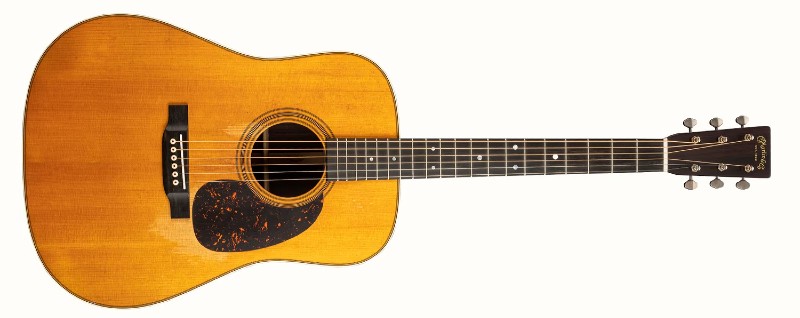
The basic dimensions of a dreadnought are typically around 40” overall length, with a max width of around 15.5”. Below we’ve listed the detailed dimensions of the average dreadnought.
| Dimension | Approximate Measurement (Inches) | Approximate Measurement (cm) |
|---|---|---|
| Overall Length | 40 | 101.6 |
| Body Length | 20 | 50.8 |
| Upper Bout Width | 11.5 | 29.2 |
| Lower Bout Width | 15.5 | 39.4 |
| Body Depth | 4.75 | 12.1 |
| Scale Length | 25.4 | 64.5 |
| Nut Width | 1.69 | 4.3 |
Dreadnoughts are known for their booming, powerful sound and are great for strumming and flatpicking.
What are the Dimensions of a Concert Guitar?
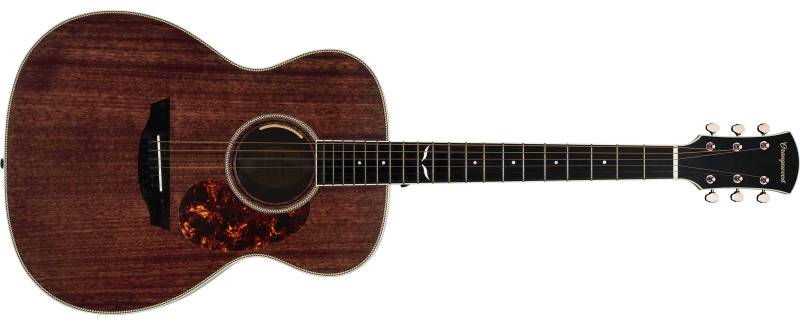
Concert guitars tend to have an overall length of around 39” and a maximum width of around 13.5”. They are slightly smaller than dreadnoughts, but are still considered to be mid-sized.
| Dimension | Approximate Measurement (Inches) | Approximate Measurement (cm) |
|---|---|---|
| Overall Length | 39 | 99.1 |
| Body Length | 19 | 48.3 |
| Upper Bout Width | 9.25 | 23.5 |
| Lower Bout Width | 13.5 | 34.3 |
| Body Depth | 3.5 | 8.9 |
| Scale Length | 24.5 | 62.2 |
| Nut Width | 1.75 | 4.4 |
Concert guitars have a curvier shape than dreadnoughts, with a narrower waist and as a result, a more balanced tone. Concert guitars are super dynamic, and perfect for a variety of genres and styles.
What are the Dimensions of a Jumbo Guitar?
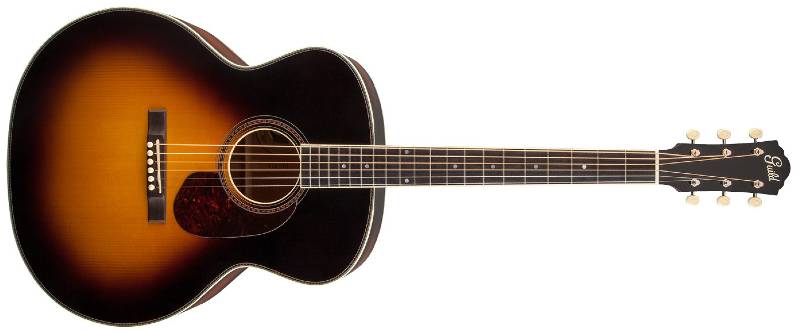
Jumbo guitars usually have an overall length of around 43” and are approx. 15.25” wide. They are the largest of the standard acoustic sizes, even larger than dreadnoughts.
| Dimension | Approximate Measurement (Inches) | Approximate Measurement (cm) |
|---|---|---|
| Overall Length | 43 | 109.2 |
| Body Length | 22 | 55.9 |
| Upper Bout Width | 12.5 | 31.8 |
| Lower Bout Width | 17.25 | 43.8 |
| Body Depth | 4.75 | 12.1 |
| Scale Length | 25.4 | 64.5 |
| Nut Width | 1.75 | 4.4 |
Because of their size, jumbos have a distinctive deep tone and commanding presence, and are often used for rhythm playing and country music.
What are the Dimensions of a Grand Auditorium Guitar?
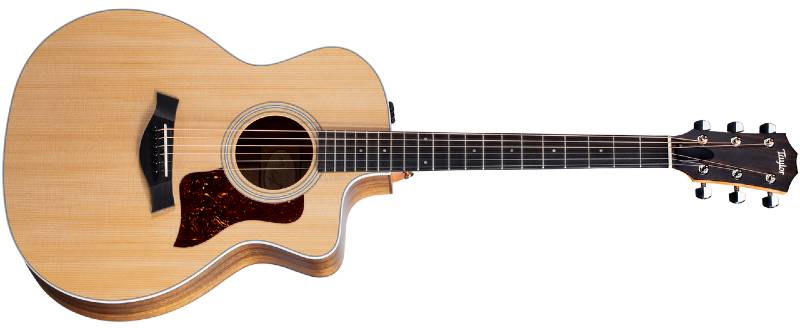
Grand auditorium guitars typically measure around 40″ from the tip of the head stock to the bottom strap nut, and have a max width of around 15“ at the lower bout. These guitars are at the upper end of medium, and are favored by fingerstyle players for their sweet, mellow tones.
| Dimension | Approximate Measurement (Inches) | Approximate Measurement (cm) |
|---|---|---|
| Overall Length | 40 | 101.6 |
| Body Length | 20 | 50.8 |
| Upper Bout Width | 11 | 27.9 |
| Lower Bout Width | 15 | 38.1 |
| Body Depth | 4 | 10.2 |
| Scale Length | 25.4 | 64.5 |
| Nut Width | 1.75 | 4.4 |
Grand auditorium guitars are versatile and well suited for a variety of playing styles, including fingerpicking and strumming. They work particularly well for playing lead guitar.
As mentioned, these dimensions are all approximations. Each manufacturer varies the measurements slightly, but the above figures are a good reference point for the dimensions of some of the most popular acoustic guitar styles.
What Impact Do the Dimensions of an Acoustic Guitar Have?
The dimensions of an acoustic guitar have an enormous impact on its tone, volume, and projection.
Tone and Volume
The size and shape of an acoustic guitar heavily influences the tone, volume, and projection of the instrument. Guitars with larger guitar bodies generally produce a deeper, fuller sound with more emphasis on the bass and lower mid frequencies, while those with smaller bodies typically produce a brighter, more focused tone with tons of midrange presence and more top end.
The shape of the guitar can also have a big impact on tone and volume. The shape influences the way in which the soundboard is able to move, and also how the soundwaves move within the body cavity.
Comfort and Playability
It may seem obvious, but the shape and size of a guitar also affect the feel and playability.
Body Size
The body size of an acoustic guitar takes into account a few different measurements. From the point at which the neck meets the body, to the bottom of the body at dead center, the width of the upper bout, the width of the lower bout, and finally the depth, which you may hear referred to as the thickness.
Guitars with smaller bodies are mostly easier to hold, and therefore easier to play, especially for smaller or younger players. Larger or taller players may find bigger guitars more comfortable as they better match their body ergonomics.
Nut Width
The nut width and scale length also impact comfort and playability. Nut width literally refers to the width of the nut, where the strings rest just below the headstock. Guitars with narrower nuts tend to be more comfortable for players with smaller hands.
Scale Length
Scale length refers to the distance between the nut and the bridge of a guitar. It is typically measured in inches, and is one of the single most important factors in determining the overall feel and playability of the instrument.
Some manufacturers have a scale length that they’re known for. Fender typically uses a 25.5” scale length, whereas Gibson uses a 24.75” scale. In the scheme of things, the difference is tiny, but the resulting difference in feel is enormous.
Shorter scale lengths are usually more comfortable for players with smaller hands, as stretching for chords and moving up and down the fretboard requires less effort. They also result in reduced string tension, which is another plus for overall comfort.
Final Thoughts on the Dimensions of an Acoustic Guitar
The dimensions of an acoustic guitar do vary between manufacturers, even when comparing models of the same body style. Understanding these differences can make the difference between buying a guitar that you hate playing, and one that fits like a glove.
Besides the comfort and ergonomics, as mentioned, the dimensions also have a big impact on tone. Remember, that larger models tend to have a bigger voice, more volume, and emphasis on the lower mids and bass frequencies. Smaller models have mellow tones, with more balance across the entire frequency range.

